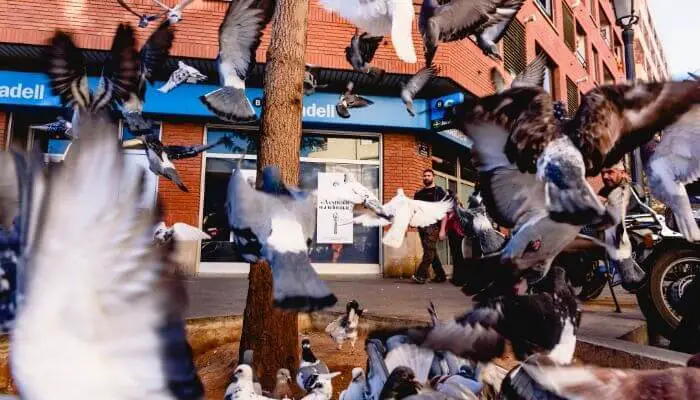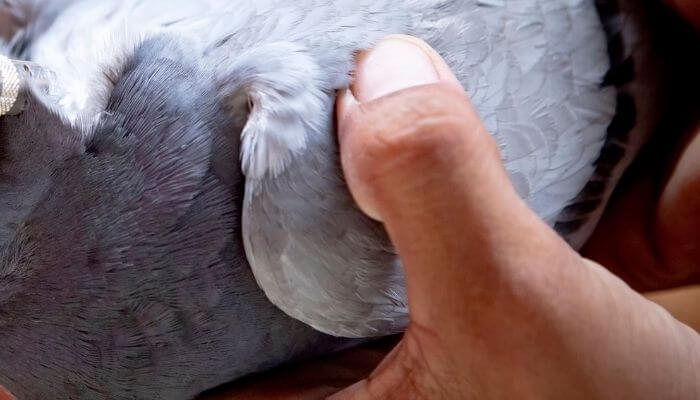Feather rot is a condition that causes the loss of feathers in pigeons.
If it’s not molting season and you see this symptom in your birds, they might have feather rot.

Pigeons’ feathers are usually normally colored, regardless of the tone.
Pigeons with feather rot not only lose their feathers, but the remaining feathers become damp, stuck together, and they typically will have an unusually gray to white color.
What Is Feather Rot In Pigeons?
This is a generic name for a condition that can be caused by various germs.
In fact, pigeons usually develop feather rot because of either a fungus or a mite infection.
The disease is much more common during the colder season when pigeons spend more of their time indoors.
This means that cleaning their living enclosure is of utmost importance, particularly the cold months between November and March.

Birds can, of course, get feather rot by coming in contact with other infected pigeons when they are outside.
Usually, this will happen when they get into fights with other birds, as the mites or fungus can also be transmitted by beak-to-feather contact.
As the condition progresses, many pigeons begin to lose their feathers, especially in their chest areas.
Severe forms of this disease can lead to its spread to the upper neck area and in some cases, it can even affect the lower part of the beak.
Bald patches will begin to appear in different parts of the pigeons’ bodies.
Sometimes, a sticky layer will be present in the areas where the feathers used to be.
Although pigeons can grow feathers again, the layer of fungus or the mites they carry on their bodies will make this process difficult.
What Causes Feather Rot
Feather rot can happen for three main reasons; molting, stress, or a pathogen.
1. Molting
Molting is perfectly normal, every pigeon will replace their feathers once a year.

Every bird is different, which is why some might experience this beginning with August, while others might start to lose their feathers at the beginning of September.
In any case, by the time mid-November comes around, the birds will have replaced their feathers as they need a healthy set for the winter.
2. Stress
Stress can be another cause of feather loss.
It can happen as a result of the pigeons being transported to and from competitions or significant changes in their living situation.

Stress can also be related to changes in a pigeons’ diet or a hierarchal change inside their group.
Some pigeons might be bullied by others, which not only causes them to be stressed but also makes it possible for the lesions resulting from the pecking to be entryways for various microorganisms.
3. Pathogens
Pathogens can cause feather loss outside of the normal molting periods.
Pathogens can vary from bacteria to viruses and even parasites such as Giardia (in some bird species).
Depending on the pigeon’s metabolism, they might even have an internal health condition that could cause feather loss.
All of these possibilities have to be eliminated or confirmed by your veterinarian when treating feather rot in pigeons.

This article was written by our qualified veterinarian Cristina.
This is part of our commitment to providing you with the most trustworthy veterinary advice for your pigeons.
What To Do If Your Pigeon Has Feather Rot
When you start your research on feather rot, you will come across a myriad of forums where pigeon aficionados communicate with each other and give each other advice.
While that’s great in many ways, it’s often impossible to ask someone who hasn’t even laid eyes on your pigeons before to suggest you use some kind of treatment for feather rot.
Sometimes, your pigeons might have other specific clinical signs that only a veterinarian or a bird pathologist might be able to discover while performing a physical examination.

The best thing to do if you suspect that your pigeons have feather rot would be to contact your local vet.
They will look at your birds and also collect samples from the affected body areas for various examinations at the laboratory.
Discovering the exact pathogen that has caused the disease is extremely important.
You might be tempted to use some treatment that one of your pigeon aficionado friends has used and has worked for their birds before.
However, your pigeons may have mites rather than a fungus, which would make some treatments virtually useless.
Some vets can use IVOMEC (which can be used both topically and as an injection). Others could also recommend another product, called DERMATOL, which fortunately works for both the fungus and the mites.
Dermatol is supposed to be sprayed on the affected areas, especially the pigeons’ chests.
Excellent hygiene is recommended in any case, whether your birds have developed feather rot as a result of contracting a fungus or mites.
You will have to clean their enclosure once every couple of days and use disinfecting solutions.
Contact Your Vet To Properly Deal With Feather Rot
Feather rot in pigeons can be caused by a fungus or by mites, which is why a correct diagnosis is necessary.
Contact your local vet or the bird pathologist whose services you have used before to find out how you can treat this condition.
